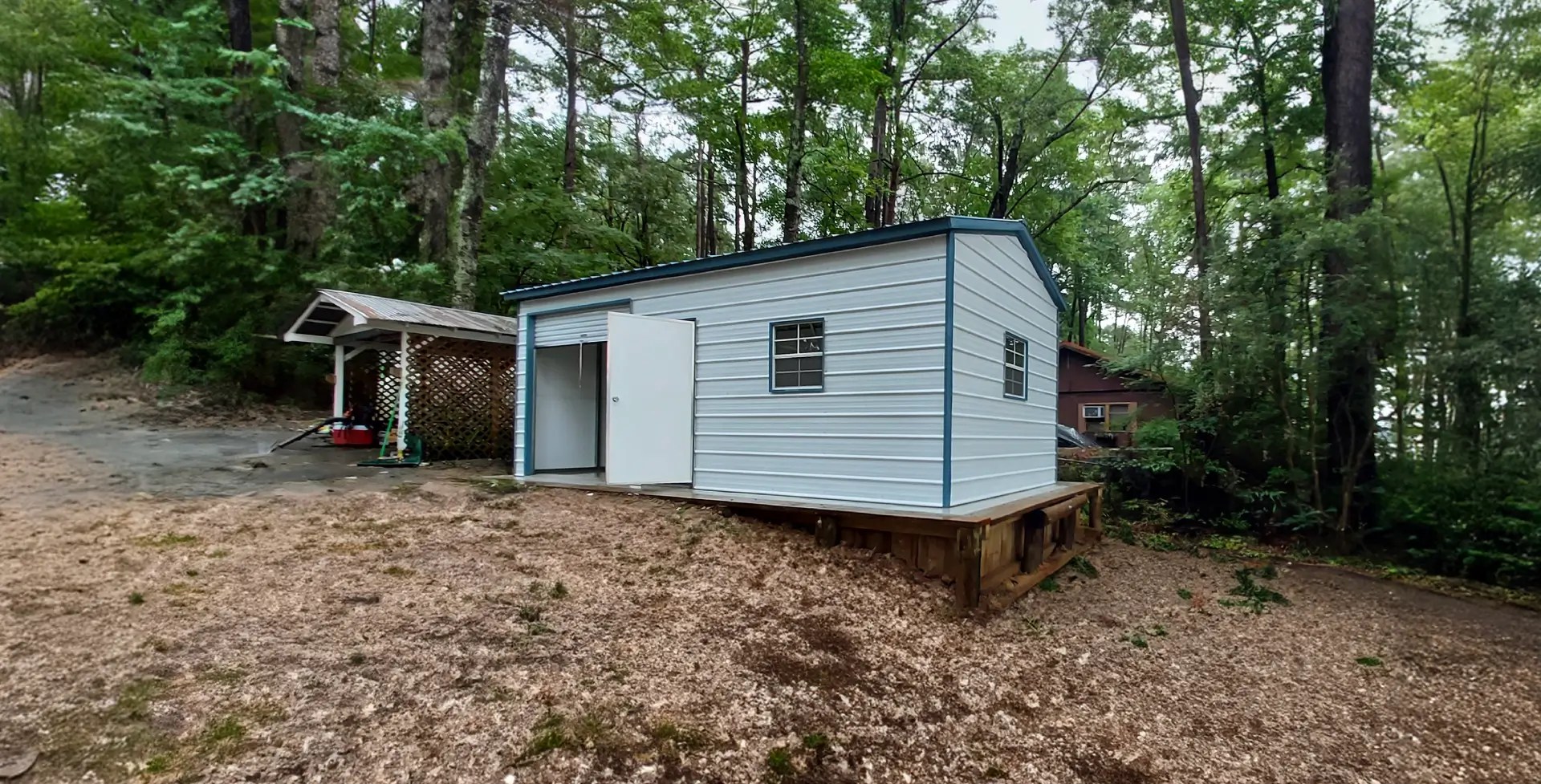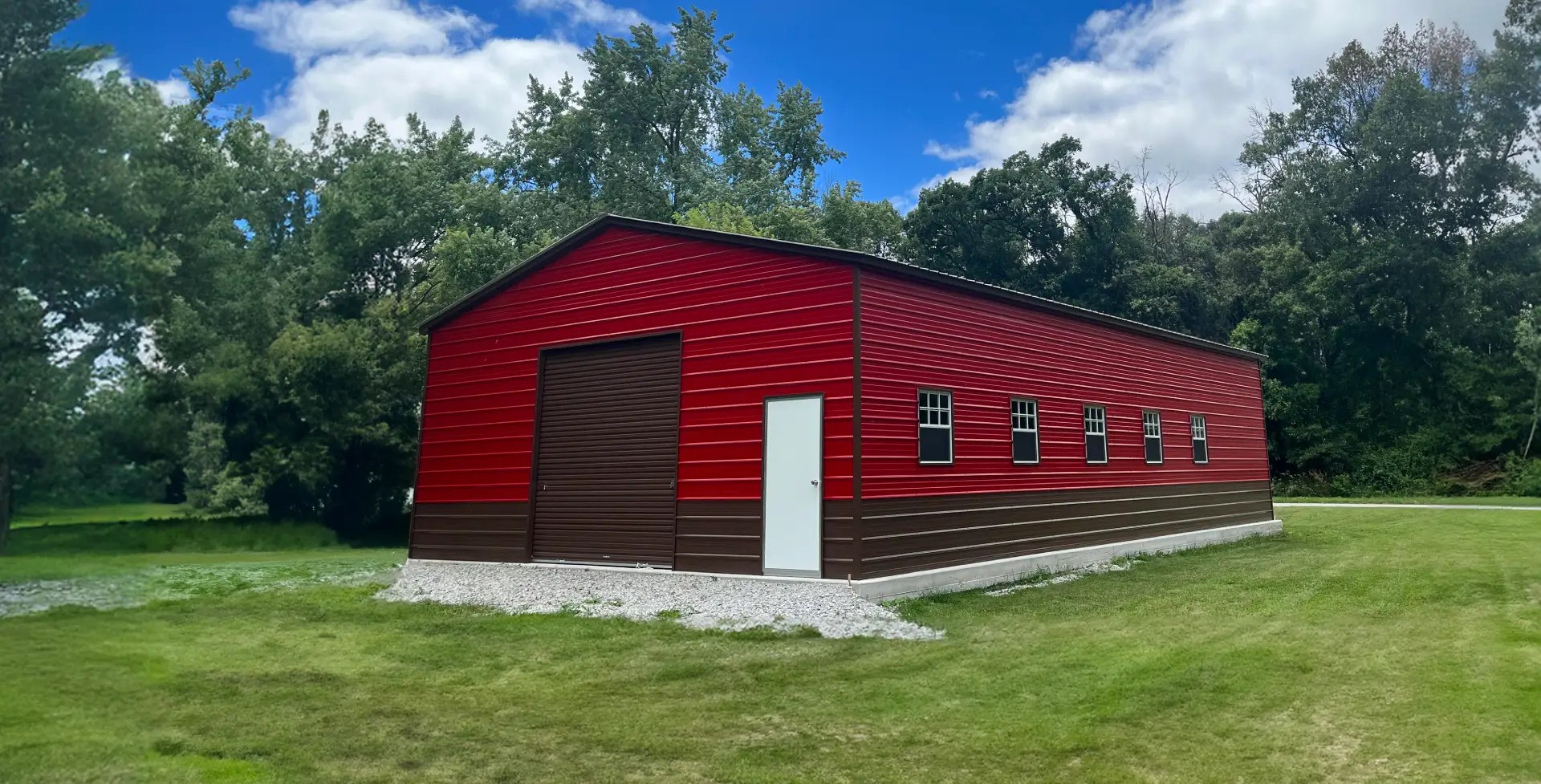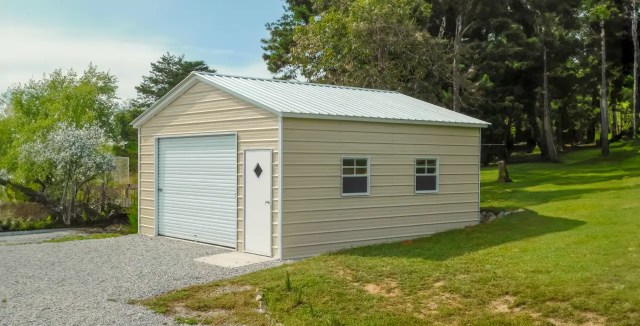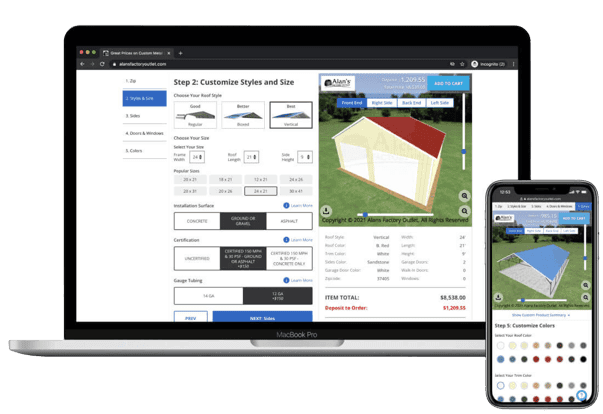Working from home is more common than ever, but trying to stay productive in your kitchen nook or on the sofa isn’t always ideal. A studio shed gives you a private, functional workspace, separate from the distractions of your house, where you can focus, create, or just work in comfort.
Data shows telework remains elevated compared to pre‑pandemic levels: About 21.6% of U.S. workers reported working from home in April 2025, and many of them do so all or most of the time.
A backyard studio shed solves that by providing a dedicated space to insulate, ventilate, wire for electricity, and customize to your needs — without major construction inside the house.
In this article, we’ll walk through the costs of setting up a backyard office shed, how to customize it for comfort and efficiency, how it compares to other workspace options, and practical tips for ensuring your studio shed supports work‑from‑home success.
What Is a Studio Shed and Why Choose One?
A studio shed is a standalone backyard structure that serves as a compact, private space for creative work, quiet focus, or personal retreat. Popular uses include home offices, art studios, she sheds, or even man caves, making it one of the most versatile additions you can make to your backyard.
Compared to converting a garage or building a home extension, a studio shed offers big advantages:
- Faster installation. No need for months of construction noise or permits.
- Cost-effective. Often far less expensive per square foot than interior remodeling.
- Minimal disruption. You keep your home intact and clutter-free.
- Built-in separation. Giving you space away from household distractions.
There are also no permanent changes to your home’s layout or structure. Best of all, these backyard studios can be tailored to your needs, whether that’s a compact 10×12-foot workspace or a spacious 20×20-foot studio for big projects or client visits. You can add insulation, windows, electricity, and custom finishes to create a structure that supports your lifestyle or career goals.
| Studio Shed vs. Home Office Conversion | ||
| Feature | Studio shed | Home office conversion |
| Installation time | Weeks, prefab ready | Months, construction heavy |
| Cost per square foot | Lower | Higher |
| Disruption to home | Minimal | Significant |
| Privacy and focus | High | Limited |
| Flexibility | Highly customizable | Depends on existing space |
Customization Options for Studio Sheds
One of the biggest advantages of choosing a studio shed kit is how easily it can be customized to meet your personal needs, style, and comfort. Whether you’re building a modern studio for remote work or transforming it into a backyard creative space, tons of upgrades can turn your shed into something truly livable and productive.
Let’s review some popular customization options:
- Natural lighting. Add windows, skylights, or glass doors to brighten your workspace and make it feel open and energizing.
- Comfort upgrades. Install insulation for year-round use and consider adding a mini split HVAC unit for heating and cooling.
- Utility setup. Wire your studio for electricity to support lighting, outlets, and equipment. Upgrade flooring for comfort and finish (like laminate, vinyl, or wood).
- Exterior options. Choose from metal roofing, adjust your roof pitch, and choose between double doors, single doors, or even French doors for a more finished look. For long-term use and style, choose durable siding materials.
You can also choose between different design aesthetics, like a modern shed with clean lines and minimal trim, or a garden shed design with shutters, flower boxes, and a cozy cottage feel.
Whether you’re looking to boost storage space, add functional living space, or build out a fully finished shed design, Alan’s Factory Outlet offers high-quality metal sheds with flexible upgrade options to match your goals.

Costs, Permits, and Building Considerations
Below are important cost factors and regulatory issues that will affect your budget, timeline, and what you can legally build.
Some major cost and regulatory items to budget for:
- Size (square footage). Larger sheds cost more in materials, labor, and sometimes permits. HomeAdvisor reports that sheds cost an average of $1,000-$15,000, with most homeowners spending around $3,500, depending mainly on size, materials, and features.
- Materials. Metal is often more durable than wood, has lower maintenance, and has better long‑term value, but sometimes it is higher up front. Wood might be cheaper up front, but it costs more with upkeep over time.
- Roof material and style. The type of roof (metal, shingle, flat, gable, high‑pitch, etc.) affects cost. Metal roofing tends to cost more initially but lasts longer and resists weather, so it requires less frequent replacement or repair.
- Upgrades. Extras like insulation, windows, skylights, HVAC, wiring, flooring, workbenches, etc., all add cost. Each add‑on increases labor and materials.
- Electrical and utility setup. If you want lighting, outlets, internet, HVAC, etc., wiring and utility work may require permits, inspections, and increased cost. These can also affect insurance and resale value.
Codes and Regulatory Requirements
- In many jurisdictions, any structure intended for human occupancy (or even frequent use as a workspace) may require a building permit, electrical permit, etc.
- Zoning or setback rules, such as the minimum distance from property lines, the maximum shed height, or the maximum square footage, often apply.
- In some states/cities, small sheds (under a certain square footage, or without utilities) may be exempt or need minimal permits. But when utilities are added or the structure is large, expect more permit fees and inspections.
- Accessory dwelling units (ADUs) give a good benchmark: The permit and regulatory costs for ADUs are often quite high. For example, in Los Angeles, permit fees for ADUs or similar structures can range from $2,000-$10,000+ just in fees, depending on size and complexity.
Long‑Term Savings via Durable Build and Insulation
Smart planning ahead of time will help make sure your shed is designed to last.
- Durable construction (e.g., steel/metal frames, quality roofing) can reduce maintenance costs over the years (painting, rot repair, pest control).
- Insulation and proper sealing reduce heating/cooling costs if using your shed as an office or workspace.
- While initial investment may be higher with quality materials and upgrades, you often recoup costs over five to 10 years via lower maintenance, longer lifespan, and possibly better property resale value.
Designing and setting up a studio shed isn’t just about building walls and adding furniture; it’s about creating a space that reflects how you work best. Whether you’re going for a clean, modern workspace or a cozy retreat, having a clear plan and aesthetic from the start will help guide your layout, lighting, and material choices.
Tips for Designing a Studio Shed
Before you build, make sure your design choices support how you’ll use the space daily. From natural light to layout, these design tips help make your workspace efficient, comfortable, and inspiring.
- Maximize natural lighting. Use skylights, large windows, or glass doors to create a bright, inviting space, and reduce your need for artificial lighting during the day.
- Create an efficient workspace layout. Design around your work
habits. Include designated zones for focus, meetings, or creative projects, and make sure there’s enough open space
to move comfortably.
- Add storage solutions. Use wall-mounted shelves, under-desk drawers, or custom cabinetry to keep clutter off your work surfaces and increase usable storage space.
- Select durable finishes. Choose flooring, wall coverings, and surfaces that can handle regular use. Opt for easy-to-clean, weather-resistant materials to keep your shed design low-maintenance.
Steps for Setting Up a Studio Shed
Once your design is ready, it’s time to bring it to life. Let’s review a simplified breakdown of building and finishing your DIY or prefab studio shed.
- Prep site (leveling, foundation, orientation). Ensure your backyard is level and select the best orientation for sun exposure and drainage. Choose your foundation: concrete slab, gravel pad, or wood platform.
- Frame structure (studs, rafters). Build or assemble the shed frame using durable studs and rafters to support the roof and walls. A solid structure is key to longevity and insulation support.
- Add insulation and drywall. Line the walls with rigid foam or fiberglass insulation, then cover them with drywall or other wall panels to make them weather-ready and comfortable year-round.
- Install flooring and finishes. Add subflooring if needed, then install your final flooring, such as laminate, LVP, or engineered wood, along with trim and paint to complete the interior.
- Wire electrical and add HVAC (mini split). Install outlets, overhead lights, and a mini split for efficient heating and cooling. Depending on your local building codes, this step may require permits or a licensed electrician.
Inspiring Uses for Studio Sheds
While remote workers are the most likely to benefit from a backyard office shed, these versatile structures can be transformed into much more. Customers at Alan’s Factory Outlet have turned their modern studios into creative, practical, and deeply personal spaces tailored to their specific goals.
Here are just a few of the ways people are using their studio sheds:
- Art studio. With ample natural light and space for easels, supplies, and
inspiration, these sheds make ideal creative retreats.
- She shed. A peaceful escape for reading, relaxing, crafting, or hosting friends,
all without stepping inside the main house.
- Man cave. A private hangout with room for hobbies, sports memorabilia, or quiet
downtime.
- Garden shed office. Combine garden tool storage with a small desk setup to keep
your green thumb and work life in sync.
- Music studio. Soundproofed and insulated for late-night jam sessions or recording projects.
Alan’s Factory Outlet customers frequently transform their storage sheds into multi-use backyard studios, with some adding built-in shelving, HVAC, and power for hybrid use as both workspace and storage. The adaptability of these sheds means they can grow with your needs, whether running a business, making music, or simply carving out a space that’s all your own.

Your Backyard Studio Shed Solution
A studio shed offers a cost-effective, flexible, and durable way to create the perfect workspace right in your backyard. Whether you need a backyard office, creative studio, or multifunctional retreat, these sheds provide the privacy and functionality remote workers and homeowners crave, without the hassle of a full home remodel.
Alan’s Factory Outlet makes it easy to design a shed that fits your exact needs. Choose from a variety of roof styles, doors, insulation options, and finishes to create an office shed that reflects your style and supports your productivity.
With fast delivery, easy customization, and long-lasting steel construction, Alan’s sheds are the go-to solution for anyone wanting convenience, comfort, and long-term value.
Explore Alan’s customizable, office-ready sheds or request a free quote today.
FAQs
Thinking about upgrading your backyard workspace? Let’s review some quick answers to the most common questions about choosing, customizing, and using a studio shed.
How much does it cost to build a studio shed?
The cost of a studio shed depends on whether you go the DIY route or buy prefab. Prefab sheds are more cost-effective in the long run due to durability and time savings. Prices vary by sq ft, materials, and upgrades, with most projects ranging from $2,000-$15,000.
What is the difference between a studio shed and an ADU?
A studio shed is designed for workspace or hobbies; it doesn’t include plumbing or a full kitchen like an ADU (accessory dwelling unit). Studio sheds are more cost-effective, typically require fewer permits, and are easier to install in most backyards.
How do I insulate a studio shed for year-round use?
Insulate between studs and rafters using spray foam, fiberglass batts, or rigid foam panels. Many homeowners also install a mini split HVAC unit to maintain year-round comfort in their workspace.
Can a studio shed be used as a home office?
Yes! A properly wired, insulated, and finished studio shed makes a comfortable, private backyard office. Alan’s Factory Outlet offers home office shed options, and you can add natural lighting, outlets, and climate control to match your work-from-home needs.




